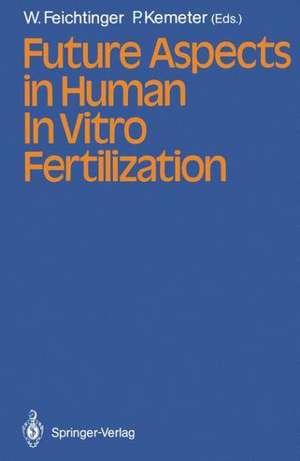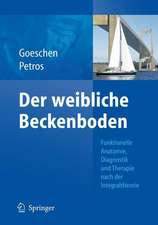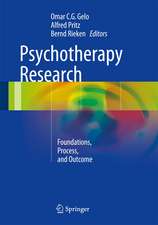Future Aspects in Human In Vitro Fertilization
Editat de Wilfried Feichtinger, Peter Kemeteren Limba Engleză Paperback – 12 dec 2011
Preț: 668.31 lei
Preț vechi: 703.49 lei
-5% Nou
Puncte Express: 1002
Preț estimativ în valută:
127.90€ • 133.03$ • 105.59£
127.90€ • 133.03$ • 105.59£
Carte tipărită la comandă
Livrare economică 08-14 aprilie
Preluare comenzi: 021 569.72.76
Specificații
ISBN-13: 9783642714146
ISBN-10: 3642714145
Pagini: 304
Ilustrații: XVI, 285 p.
Dimensiuni: 156 x 244 x 16 mm
Greutate: 0 kg
Ediția:Softcover reprint of the original 1st ed. 1987
Editura: Springer Berlin, Heidelberg
Colecția Springer
Locul publicării:Berlin, Heidelberg, Germany
ISBN-10: 3642714145
Pagini: 304
Ilustrații: XVI, 285 p.
Dimensiuni: 156 x 244 x 16 mm
Greutate: 0 kg
Ediția:Softcover reprint of the original 1st ed. 1987
Editura: Springer Berlin, Heidelberg
Colecția Springer
Locul publicării:Berlin, Heidelberg, Germany
Public țintă
ResearchDescriere
While the organization of an international congress on in vitro fertilization (IVF) was an entirely new venture for us in 1983, since we had no experience but were full of optimism, we approached the organization of a second Congress in Vien na in 1986 much more calmly. Our experience had increased as had the readiness of many of our friends to help and of people interested in cooperating. However, would our Congress not lose its originality on account of the increased routine? This was certainly a possible danger which we wanted to prevent by means of two counter measures. The first concerned the scientific program: the new and trend-setting aspects of IVF would be discussed primarily rather than the results of traditional methods. The second measure concerned the social program, aimed more at private contacts in the intimate and familiar atmosphere of homes and workplace rather than meetings in luxurious but impersonal public institu tions. We believe that both these measures achieved the desired effect. Although we could not avoid some events taking place at the same time, the most important problems were treated and discussed jointly. Thus, the Congress was easy to survey, and all topics were thoroughly discussed.
Cuprins
Opening Address.- The Evolution of In Vitro Fertilization Technology.- Continuing Pregnancy Rates by Number of Concepti Transferred.- Transfer Results After One-Step Freezing and Thawing of Bovine Embryos.- The Viability of Bovine “Half” Embryos Produced Before or After Liquid Nitrogen Freezing.- The Mouse Egg as a Model in In Vitro Fertilization and Cryobiology.- Cryopreservation of Mouse Eggs in an In Vitro Fertilization/Embryo Transfer Program.- Successful In Vitro Fertilization of Frozen-Thawed Rabbit and Human Oocytes.- Human Oocyte and Embryo Freezing.- Human Ovarian Follicular Antigens.- Culture of Human Trophoblastic Tissue: A Potential Tool for Improvement of Early Embryo Culture and Transfer.- Pregnancies Following Fixed Schedule Ovulation Induction and Embryo Cryopreservation During Diagnostic Infertility Laparoscopy.- Human Embryo Freezing in an In Vitro Fertilization and Embryo Transfer Program.- The Freezing of Early Human Embryos and Blastocysts.- Freezing Human Oocytes Using Rapid Techniques.- Fertilization by Microinjection of Human Sperm in Hamster and Human Oocytes.- Artificial Insemination Using a Micromanipulator.- Nonsurgical Ovum Transfer: The Harbor-UCLA Experience.- Oocyte and Embryo Donation in Women with Absent Ovarian Function.- Pregnancies after Replacement of Fresh and Frozen-Thawed Embryos in a Donation Program.- Pregnancies in the Absence of Ovaries — Parameters Affecting Outcome.- The Willingness of Infertile Women to Donate Eggs.- Religious Aspects of Gamete Donation in In Vitro Fertilization and Embryo Transfer Programs.- Experimental Genetics of the Mammalian Embryo.- The Transformation of New Genetic Material into Pluripotential Embryonic Cells Grown In Vitro and Their Incorporation into Chimaeric Animals.- Expression of Foreign Genes in Transgenic Mice.- Blastocyst-Derived Embryonic Stem Cells as a Model for Embryogenesis.- Experimental Approaches to the Preimplantation Ova with Emphasis on Cytoplasmic Factors, Cell Cycle and Intercellular Connections.- Electric-Field-Induced Fusion of Blastomeres.- Microsurgical Experiments on Embryos in Farm Animals — Basic and Applied Aspects.- Experimental Polyembryony in Mammals.- Towards Cloning of Domestic Animals.- Stages in Early Human Development.- Potential of Research von Human Embryos.- Gene Activation in the Human Embryo Developing In Vitro.- Genetic Analysis of Human Embryos Prior to Implantation: Future Applications of In Vitro Fertilization in the Treatment and Prevention of Human Genetic Diseases.- Morphologic and Cytologic Study of Human Embryos Obtained by In Vitro Fertilization.














